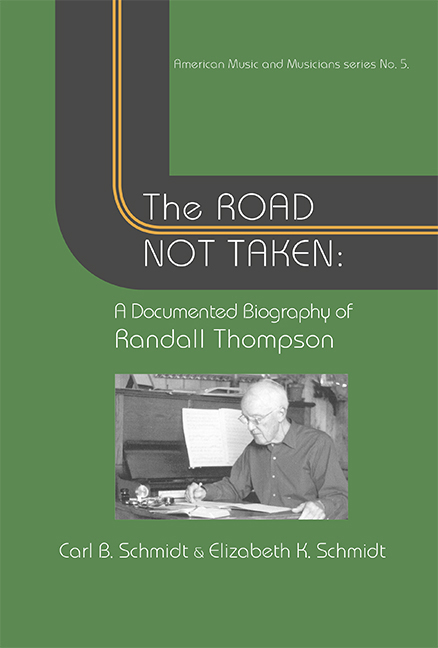Book contents
- Frontmatter
- Contents
- List of Illustrations
- List of Tables
- Library Sigla and Abbreviations
- Guide to Harvard University and Oberlin College Collections Referenced by Box Number
- Preface: Gateway to a Career
- Acknowledgments
- Chapter I Family History and Formative Years
- Chapter II Undergraduate Study at Harvard College (1916-20)
- Chapter III Lessons with Ernest Bloch and Graduate Study at Harvard University (1920-22)
- Chapter IV Damrosch Fellowship Years at the American Academy in Rome (1922-25)
- Chapter V Courtship and Marriage (1925-27)
- Chapter VI New York City—Wellesley College—A Guggenheim Fellowship (1927-31)
- Chapter VII Guest Conducting, Reception of Symphony no. 2, and College Music: An Investigation (1931-35)
- Chapter VIII Life after College Music: An Investigation (1935-37)
- Chapter IX The University of California at Berkeley (1937-39)
- Chapter X Curtis Institute of Music: The Hiring Process (Spring and Summer 1939)
- Chapter XI Curtis Institute (Fall 1939-Spring 1941)
- Chapter XII The University of Virginia (Fall 1941-Spring 1945)
- Chapter XIII Princeton University (Fall 1945-Spring 1948)
- Chapter XIV Return of a Favored Son: Harvard University (Fall 1948-Spring (1957)
- Chapter XV Harvard University (Summer 1957 to July 1, 1965)
- Chapter XVI The Early Retirement Years (1965-75)
- Chapter XVII The Final Years (1975-84)
- Chapter XVIII Recapitulation and Coda
- Bibliography of Works Cited by Abbreviations
- Index
Chapter IV - Damrosch Fellowship Years at the American Academy in Rome (1922-25)
- Frontmatter
- Contents
- List of Illustrations
- List of Tables
- Library Sigla and Abbreviations
- Guide to Harvard University and Oberlin College Collections Referenced by Box Number
- Preface: Gateway to a Career
- Acknowledgments
- Chapter I Family History and Formative Years
- Chapter II Undergraduate Study at Harvard College (1916-20)
- Chapter III Lessons with Ernest Bloch and Graduate Study at Harvard University (1920-22)
- Chapter IV Damrosch Fellowship Years at the American Academy in Rome (1922-25)
- Chapter V Courtship and Marriage (1925-27)
- Chapter VI New York City—Wellesley College—A Guggenheim Fellowship (1927-31)
- Chapter VII Guest Conducting, Reception of Symphony no. 2, and College Music: An Investigation (1931-35)
- Chapter VIII Life after College Music: An Investigation (1935-37)
- Chapter IX The University of California at Berkeley (1937-39)
- Chapter X Curtis Institute of Music: The Hiring Process (Spring and Summer 1939)
- Chapter XI Curtis Institute (Fall 1939-Spring 1941)
- Chapter XII The University of Virginia (Fall 1941-Spring 1945)
- Chapter XIII Princeton University (Fall 1945-Spring 1948)
- Chapter XIV Return of a Favored Son: Harvard University (Fall 1948-Spring (1957)
- Chapter XV Harvard University (Summer 1957 to July 1, 1965)
- Chapter XVI The Early Retirement Years (1965-75)
- Chapter XVII The Final Years (1975-84)
- Chapter XVIII Recapitulation and Coda
- Bibliography of Works Cited by Abbreviations
- Index
Summary
A man who has not been in Italy,
is always conscious of an inferiority,
from his not having seen what it is
expected a man should see.
(Jules Massenet)
BACKGROUND AND FOUNDING OF MUSICAL FELLOWSHIPS AT THE AMERICAN ACADEMY
The idea of establishing a place in Europe where American architects, paint¬ers, and sculptors could congregate and study had taken root when a group was planning for the 1893 World's Columbian Exposition in Chicago. A temporary American School for Architects in Rome was established in 1894, but this was dissolved after two years and reformed as the American Acad¬emy in Rome. Just after the turn of the century, with the financial assistance of founding members from New York including J. P. Morgan, J. P. Morgan Jr., John D. Rockefeller Jr., and the Carnegie and Rockefeller Foundations among others, an endowment was established. After functioning in various locations, the Academy was finally situated at the Villa Aurelia on Rome's Janiculum Hill and in buildings on adjacent land subsequently purchased by J. Pierpont Morgan, Sr. and transferred to the American Academy. Eighteen years later, the American School of Classical Studies merged with the Acad¬emy thus combining fine arts and classical studies under the auspices of a single administration.
In 1915 Academy Secretary C. Grant La Fargue cogently summarized the Academy's intent.
The Academy is not a school; it is not for technical training or the teaching of any rudiments; it does not have classes nor does it even impose a very rigid, prescribed course. Its beneficiaries are those who have already advanced far beyond the preliminary stages of their various callings; fre-quently they may be people ready to embark, or who have embarked, upon their professional careers. All of them come to Rome for the enlargement and fuller development of their knowledge and talents through first-hand contact with the record of the past. Next—and this cannot be too plainly or too emphatically stated—what the Academy offers, its Prize of Rome, is not meant to be a benevolent assistance to worthy youth, but the means whereby the best material discoverable may be raised to its highest powers for the elevation of American art and letters… . Fellowships in Music will be established when Lamond's are available; there are similar and equally cogent reasons for the advanced study of this art in Italy as in the case of the other arts.
- Type
- Chapter
- Information
- The Road Not TakenA Documented Biography of Randall Thompson, 1899–1984, pp. 111 - 178Publisher: Boydell & BrewerPrint publication year: 2018

